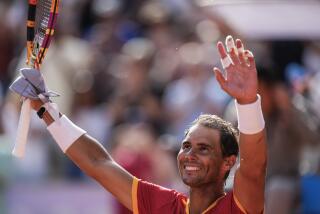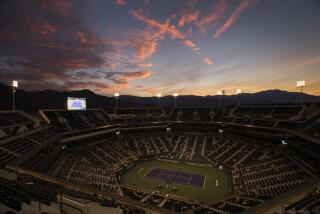Tennis May Be Wheezing, but It’s Not Dead Yet
- Share via
NEW YORK — They buzz around the grounds of the U.S. Open, lining up for grilled chicken and white wine. They wander past booths selling $20 T-shirts and $220 purple warmup suits. And, like all good fans, they wait outside the players’ lounge, hoping for a glimpse of Andre Agassi or Gabriela Sabatini.
Tennis, like many sports these days, faces serious trouble. But if it’s dying, as some insist, a death certificate could not be produced after two weeks of play at the U.S. Open.
Comedian Alan King, a longtime tennis patron, is wearing a straw hat and standing in a walkway behind the Open’s stadium court. He acknowledges the game is going through a rough stretch--few rivalries, weakened TV ratings, poor equipment sales.
But dying? He’s heard that talk before.
“You mean like the death of Broadway?” he says.
It is the diminished rivalries fans feel most acutely. The heyday of tennis in the late 1970s offered Jimmy Connors, John McEnroe and Bjorn Borg. There was Chris Evert and Martina Navratilova, as peerless a rivalry as any in sports.
Now the headline acts are gone. Evert concentrates on motherhood. Navratilova makes her farewell tour. Monica Seles and Jennifer Capriati remain on sabbatical. Steffi Graf awaits her equal.
The electricity on the men’s side is generated by the likes of Agassi and Boris Becker. But Becker is too often mired in a brooding, philosophical funk, and Agassi simply has not won enough come the Grand Slams.
So it didn’t take much for this U.S. Open to become Agassi’s tournament. He was not even among the 16 seeds, but he was there for the final weekend. As for the top seeds, they became practically an extinct species.
Among the eight men’s quarterfinalists, only three were seeded. At one point, deep into the tournament, a possible final loomed between Jonas Bjorkman and Bernd Karbacher.
This absence of glamour may account for one scalper’s woes on the boardwalk leading to the stadium. He takes a fistful of tickets from his pocket, promising good seats, whatever the day.
“Oh, man,” he says. “Last year at this time I was up $5,000. Now I’m down a G.
“The market’s not what it’s supposed to be,” he says.
Inside the gates of the National Tennis Center, where cellular phones chirp like crickets in the night, business is better.
The Wilson tent is one of four stalls selling rackets on the grounds. Jon O’Kelley, a promotions manager, says Wilson is holding its own in racket sales at the Open. But, he adds, the industry is slumping.
Chris Watase, a sales representative for Yonex, says he’s selling more rackets than last year at his Open booth.
“People are grabbing rackets,” he says. “The interest is there.”
Vicki Kiger is interested. She’s over on Court 22, eating lunch while watching a doubles match. Kiger is a marketing director for a video chain and made the trip from Virginia to watch tennis.
She misses the dazzle of Connors and McEnroe, but insists Agassi will do quite nicely. She says tennis needs more of Luke and Murphy Jensen, the doubles-playing brothers who bring a bungee-jumping sensibility to the game.
“It’s a show,” Kiger says, “and everything in sports now has to be a show.”
The Jensens are one of the best shows going in tennis. At a recent match at the Open, they packed an outside court while Sabatini played to empty seats in the stadium.
The Jensens wear star-spangled shirts. They touch rackets on good shots, like basketball players slapping palms. Given the chance during a rain delay, they’ll whack a ball with a kid from the stands.
Luke Jensen, with shoulder-length blond hair and different colored socks, is ambidextrous. He’ll switch from one hand to the other when serving. It makes no difference to the crowd that the Jensens, the 1993 French Open champions, were unseeded at the Open.
The brothers want players’ names on shirts and coaches on the court. They want splashy introductions like at an NBA game. And, of course, lots of music. They want the game’s aristocratic baggage put away for good.
“Tennis has an attitude problem,” says Luke Jensen.
“Who’s game is it anyway?” asks Murphy Jensen.
Mary Carillo, the former player and commentator, thinks the Jensens are good for the sport. She calls tennis a “fractured entity” and “in denial.”
“I don’t think it’s dying,” she says from the concrete steps behind the CBS booth. “But,” she adds, in her best Jewish grandmother’s voice, “it’s got a headache like you wouldn’t believe.”
Like the Jensens, she thinks music would pump life into tournaments. More important, she would like to see tour schedules reduced and the players assume greater responsibility toward fans, sponsors and the media.
J. Howard (Bumpy) Frazer, the outgoing president of the U.S. Tennis Assn., wants change as well, but scoffs at pronouncements of tennis’ imminent death.
“Absolute baloney,” he says.
From his seat at a patio table, Frazer talks of the great skills of the players and the near-record crowds at the Open. He acknowledges the structure of tennis is in need of streamlining, and he wishes matches at the Open didn’t run past midnight. But he insists tennis is doing fine.
“I’m not looking at this through rose-colored glasses,” he said. “We’re going to get it back. It’s not a crisis. It’s a bit of a downturn. I’ve never seen anything in life that didn’t have a few ups and downs.”
Michael Stich, the German star who lasted to the final weekend, calls the drop in popularity, in Europe as well as the United States, inevitable.
“We have had a very, very good 15 years of tennis,” he says. “We had great players, great tennis. The economy, all the business, went with the growing perspective of tennis. And now you just can’t keep going like this. It’s just a normal thing.”
More to Read
Go beyond the scoreboard
Get the latest on L.A.'s teams in the daily Sports Report newsletter.
You may occasionally receive promotional content from the Los Angeles Times.










